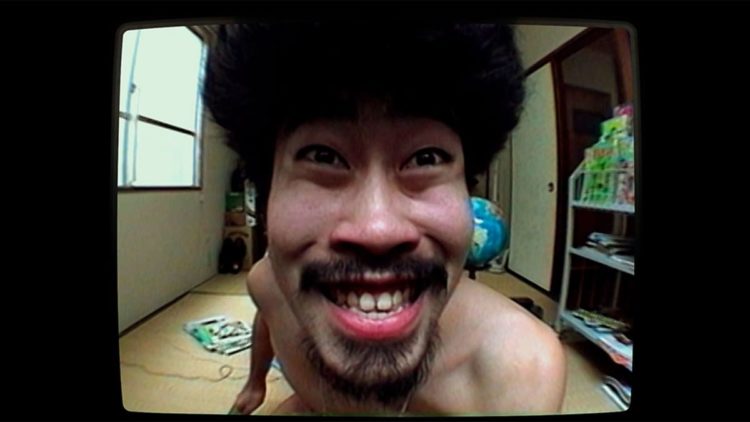The tagline of Clair Titley’s The Contestant is “The naked truth about the world’s first reality star.” The show referred to is Susunu! Denpa Shōnen, which aired in Japan from January 1998 to March 2002, and which saw participants––usually young people eager for fame––complete grueling challenges, such as hitch-hiking from South Africa to Norway or traveling from India to Indonesia by peddle boat. The star is Tomoaki Hamatsu, better known as “Nasubi” (“eggplant” in Japanese, owing to the size and shape of his head), who appeared on Denpa Shōnen’s now infamous program A Life in Prizes. The question that the show posed was simple: how long could someone survive on competition prizes alone?
To answer it, the show’s producer, Toshio Tsuchiya, had Nasubi blindfolded and taken to a secret location––a dreary one-room apartment somewhere in Tokyo––where he was asked to strip naked and was instructed to use a selection of magazines and a large stack of postcards to enter sweepstakes in order to win prizes. The challenge would be over, he was told, when he had won prizes worth a total of one million yen, and only then would the highlights of his ordeal be shown on TV. In reality, however, his life was broadcast every week, and the show soon became a hit all over Japan, with viewership numbers in excess of 30 million.
In the first week of the challenge, Nasubi entered 963 competitions, winning nothing. The first prize he won was 12 cartons of fiber jelly, which he later fashioned into makeshift pots for cooking rice; other prizes included strawberries, stuffed toys, tins of dog food, car tires, a pair of shoes, a lobster, and women’s underwear. The show immediately became Tsuchiya’s obsession, and he scorned those who questioned its validity. For example, when someone on the Internet accused him of only filming Nasubi filling in postcards and winning prizes, he decided to set up a 24-hour livestream of Nasubi, which was maintained by a team of 50 people, including someone whose job it was to operate the “modesty joystick.”
So great was the obsession that when Nasubi reached his goal, after 11 months in the cramped apartment, Tsuchiya took him to South Korea, bought him some barbecued meat and let him ride a few rollercoasters, before blindfolding him once again and asking him to take part in a new challenge: A Life in Prizes: Korea Edition. After a three-hour-long discussion with Tsuchiya, which the final cut neglected to show, Nasubi consented. And so began another sadistic adventure in which Nasubi’s goal was changed continually, from having to win prizes worth the price of a plane ticket back to Japan, to prizes worth a business-class ticket, then a first-class ticket, until the torment couldn’t be taken any further. The big reveal––that his life was being broadcast on TV all along––is now legendary in Japanese television history.
The Contestant provides a clear summary of this strange story, but with a good deal more psychological detail than was provided in the original show. Perhaps the most interesting of these is Nasubi’s answer to the rather obvious question of why he didn’t leave the room, which he was free to do at any time: “Psychologically, you feel that rather than escaping or doing something radical, staying put, not causing trouble is the safest option. It’s a strange psychological state. You lose the will to escape.” When set against the fact that Tsuchiya was obsessed with his so-called experiment and relished the God-like power that it gave him, this response may also answer the deeper question of how such a show was allowed to continue in spite of its subject’s extreme loneliness and frequent suicidal thoughts––namely, that Tsuchiya and Nasubi were each incentivized to outlast the other, resulting in a mutually destructive stalemate, which seems to have lasted to this day.
In addition to these interviews, we also hear from Nasubi’s friends and family, though they don’t seem altogether pleased by the idea of going over what is by now well-trodden ground. Fortunately, these segments are used only sparingly, with most of the runtime being taken up by the bewildering and often rather shocking archival footage of the show, which has been neatly trimmed by editors Rachel Meyrick and Katie Bryer and for which Fred Armisen provides an amusing––and, as far as intonation is concerned, reasonably accurate––English dubbing of the show’s excitable hosts. The latter, especially, is essential for appreciating the mock-supportive tone that the show took towards its depressed and emaciated subject.
Except for a hurried epilogue about Nasubi’s life after A Life in Prizes, Titley does not stray far from her subject matter, and sensibly declines to arbitrate on the question of whether the show was an empowering trial or a vehicle for public schadenfreude. Less sensible, however, is her decision not to show how Nasubi’s experience on Denpa Shōnen influenced reality TV as we know it today, since it is precisely this intersection between the personal story and social phenomenon that the film is so often lacking. Disappointing, too, is Takehiro Hira’s narration of the diaries Nasubi kept during the challenge; his tone is often too mannered to arouse any genuine sympathy, though just what tone he ought to have taken is hard, if not impossible, to say. Nevertheless, The Contestant provides a breezy chronology of one of television’s mostly baffling shows, as well as an entertaining, and sometimes painfully affecting, portrait of a man who, after years of using comedy as a means of self-defense, didn’t seem to know himself whether he was waving or drowning.
The Contestant arrives on Hulu on May 2.
The post The Contestant Review: A Breezy Look at a Baffling Reality Show Challenge first appeared on The Film Stage.





